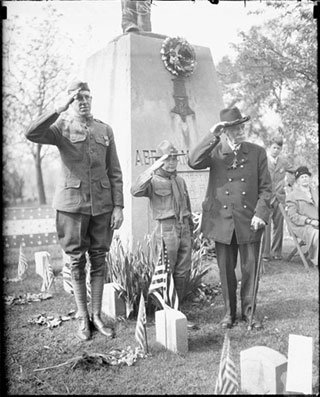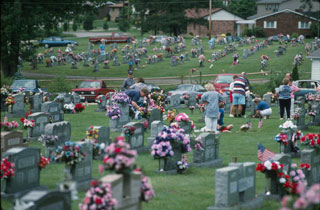Human Flower Project
Monday, May 29, 2006
Decoration Day
North and South are still at odds over who initiated Memorial Day.

Civil War veteran salutes with a Boy Scout and a soldier
at a gravesite in Oak Woods Cemetery, Chicago, Illinois
Decoration Day, 1927
Photo: Chicago Daily News
from Library of Congress, American Memory
When we dream of going back in time, to any period of history, there’s one era we would NOT choose to visit: the years of the U.S. Civil War, 1861-1865.
In a small way, though, we revisit this dreadful time each Memorial Day. “The 30th day of May, 1868, is designated for the purpose of strewing with flowers, or otherwise decorating the graves of comrades who died in defense of their country….” So read an order of the Grand Army of the Republic, Washington, D.C., 138 years ago. This may be the U.S. military’s one floral command.
Fortunately, the military doesn’t run this country (yet, anyway). It’s primarily been civilians who have carried out this order, lovingly. The custom goes back at least two years before the army proclamation, when three women in Columbus, Mississippi, decided to decorate the graves of both Union and Confederate soldiers buried in Friendship Cemetery. After the gruesome Battle of Shiloh, “Hundreds of wounded troops, – both Confederate and Union – were shipped south on railroad cars from Corinth, Mississippi, near the Tennessee line to makeshift hospitals in towns such as Columbus. Many of the soldiers died on the trains; others survived into the late spring and early summer of 1862 but ultimately perished.” More than 2000 soldiers are buried here.
Felder Rushing writes that when news of the Columbus graveyard tribute “reached the North, an article in the New York Tribune cited the ladies for their unselfish act; many people were surprised that Southern ladies would mark the graves of Union soldiers with flowers. But war widow Augusta Murdoch Sykes, one of the Columbus planners, pointed out that ‘after all, they are somebody’s sons.’” The tradition of “Decoration Day” seems to have spread quickly on both sides of the Mason-Dixon Line, a reconciliatory custom born of grief and weariness—conditions only flowers of the late spring can meet.
Weirdly, some would extend the battle, over who gets credit for Decoration Day. Here, die-hard Northerners give their version; here, Confederate flag waving, is another view.
 Decoration Day, Pineview Cemetery, West Virginia (1996)
Decoration Day, Pineview Cemetery, West Virginia (1996)
Photo: Terry Eiler
Only in 1971 was the federal holiday Memorial Day fixed on the last Monday in May. It “marks the unofficial beginning of the summer season in the United States. It is still a time to remember those who have passed on, whether in war or otherwise. It also is a time for families to get together for picnics, ball games, and other early summer activities.”
In the South, the custom remains strong, though it’s not always observed on Memorial Day. At rural cemeteries where there’s no groundskeeping crew, descendents often set aside a weekend in the spring or summer to meet and clean up the ancestors’ graves. The occasion melds Decoration Day and family reunion. Make sure to see the photographs Terry Eiler took in West Virginia, 1996. Terry’s photo album appears, along with the Chicago picture above and thousands more materials, at the Library of Congress site called American Memory.




